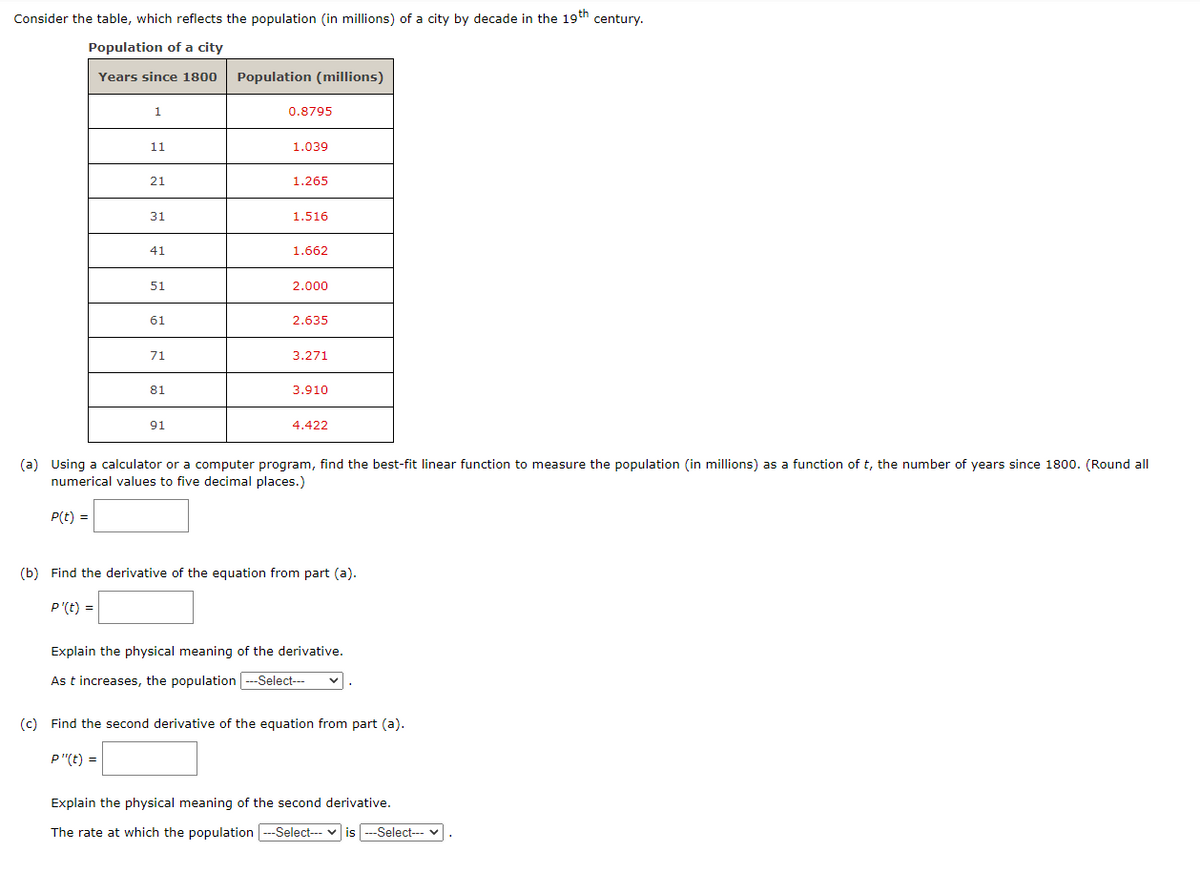(a) Using a calculator or a computer program, find the best-fit linear function to measure the population (in millions) as a function of t, the number of years since 1800. (Round all numerical values to five decimal places.) P(t) = (b) Find the derivative of the equation from part (a). P'(t) = Explain the physical meaning of the derivative. As t increases, the population --Select--- (c) Find the second derivative of the equation from part (a). p"(t) = Explain the physical meaning of the second derivative. The rate at which the population ---Select--- v is ---Select--- ·
(a) Using a calculator or a computer program, find the best-fit linear function to measure the population (in millions) as a function of t, the number of years since 1800. (Round all numerical values to five decimal places.) P(t) = (b) Find the derivative of the equation from part (a). P'(t) = Explain the physical meaning of the derivative. As t increases, the population --Select--- (c) Find the second derivative of the equation from part (a). p"(t) = Explain the physical meaning of the second derivative. The rate at which the population ---Select--- v is ---Select--- ·
Algebra & Trigonometry with Analytic Geometry
13th Edition
ISBN:9781133382119
Author:Swokowski
Publisher:Swokowski
Chapter3: Functions And Graphs
Section3.3: Lines
Problem 76E
Related questions
Question
The dropdowns that say "select"on part b and c are saying "is it increasing, decreasing or constant"

Transcribed Image Text:Consider the table, which reflects the population (in millions) of a city by decade in the 19th century.
Population of a city
Years since 1800
Population (millions)
1
0.8795
11
1.039
21
1.265
31
1.516
41
1.662
51
2.000
61
2.635
71
3.271
81
3.910
91
4.422
(a) Using a calculator or a computer program, find the best-fit linear function to measure the population (in millions) as a function of t, the number of years since 1800. (Round all
numerical values to five decimal places.)
P(t) =
(b) Find the derivative of the equation from part (a).
P'(t) =
Explain the physical meaning of the derivative.
As t increases, the population --Select---
(c) Find the second derivative of the equation from part (a).
P"(t) =
Explain the physical meaning of the second derivative.
The rate at which the population ---Select--- v is
--Select---
Expert Solution
This question has been solved!
Explore an expertly crafted, step-by-step solution for a thorough understanding of key concepts.
This is a popular solution!
Trending now
This is a popular solution!
Step by step
Solved in 3 steps with 3 images

Recommended textbooks for you

Algebra & Trigonometry with Analytic Geometry
Algebra
ISBN:
9781133382119
Author:
Swokowski
Publisher:
Cengage


Trigonometry (MindTap Course List)
Trigonometry
ISBN:
9781337278461
Author:
Ron Larson
Publisher:
Cengage Learning

Algebra & Trigonometry with Analytic Geometry
Algebra
ISBN:
9781133382119
Author:
Swokowski
Publisher:
Cengage


Trigonometry (MindTap Course List)
Trigonometry
ISBN:
9781337278461
Author:
Ron Larson
Publisher:
Cengage Learning

Glencoe Algebra 1, Student Edition, 9780079039897…
Algebra
ISBN:
9780079039897
Author:
Carter
Publisher:
McGraw Hill

Big Ideas Math A Bridge To Success Algebra 1: Stu…
Algebra
ISBN:
9781680331141
Author:
HOUGHTON MIFFLIN HARCOURT
Publisher:
Houghton Mifflin Harcourt

Algebra and Trigonometry (MindTap Course List)
Algebra
ISBN:
9781305071742
Author:
James Stewart, Lothar Redlin, Saleem Watson
Publisher:
Cengage Learning